
Looks more like the wikipedia article now that it’s a few days older. And there is more of it.

Looks more like the wikipedia article now that it’s a few days older. And there is more of it.

Seen while walking around the lake this afternoon.
Just for the record.
This is my piece of the panel from Minicon 46 (as prepared; this is my notes and example pictures, rather than any sort of actual record of what I said). Dave Romm’s gallery is here.
Effort is time or concentration, weight lugged, money, whatever. I’m going to talk about things that are free—costing only time and concentration.
Quality is completely subjective. Even on very basic things—should something be in focus in a picture? Anything? Sometimes a photo works without even that.
Photos have different purposes—memory, art, communicating to others, history, etc. The idea here is for you to take the photos YOU want to take
But, basically, this is about how you can work harder for better photos—most efficiently.
This is about using what you have, not about spending lots of money on fancy equipment.
Looking at a photo, which just sits there and is flat, causes the human visual system to behave differently than when we’re looking at a real scene. To take better photos, you need to learn to see what will be apparent in the flat photo. You need to pay attention to the edges, and to juxtapositions at a distance (which we mostly ignore live, but become obtrusive in a flat static photo; the “pole growing out of the head” is the classic example).
Digital photos are free. Experiment. Deliberately try things changing one variable at a time. Examine the results and see what you can learn.
Big wastebaskets make good photographers. Shoot heavy, display light. (No, I’m not very good at practicing this.)
Decide where the frame boundaries are. And don’t be afraid to crop tighter in post-processing.
Photos of a person in isolation are sometimes very nice, but you don’t need that many of any given person. Shots of them in an environment are more interesting, or interacting with another person.
Composition is a graduate course, which I’m not the person to teach. Just do what looks good to you.
Whole room, small groups, couples, individual portraits. The wider shots are much the hardest—or maybe that’s individual.
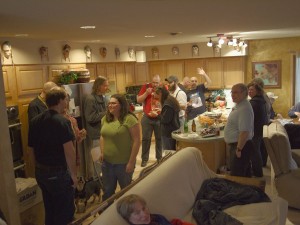
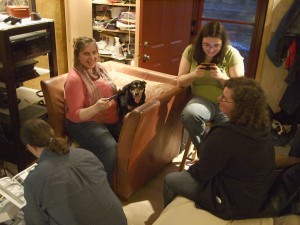


Moving towards, away from, and around your subject changes how it looks in relationship to everything else in the frame. Think about this, experiment with this. You can get rid of distracting backgrounds, or introduce interesting relationships. Don’t forget up and down! Very often, a photo looks better from a bit below the eye level of the subject. (The technical term for these relationships between objects in the scene is “perspective”.)
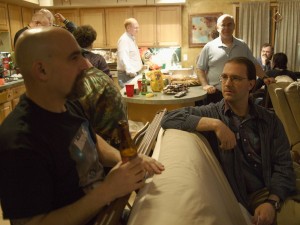
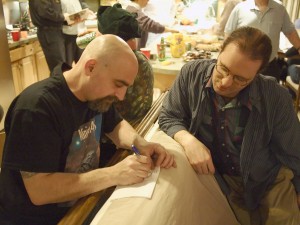
Mostly in people pictures you really really really need to have the eyes. Preferably open. Ideally, not blocked by the glasses frame.
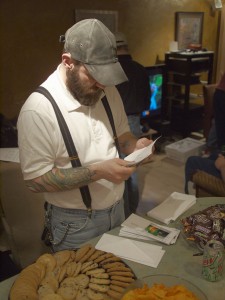

The time it takes the camera to focus is the biggest part of the delay between pushing the button and actually taking the picture. Most cameras let you pre-focus by half-pressing the button (and holding it). Then you can take the actual picture, with much less delay, by pushing the button the rest of the way. (DSLRs also focus MUCH faster than P&S, because they use a completely different technology to do so).
It’s easy to check whether you got what you wanted, these days. Remember that you have to zoom in quite a bit to accurately judge whether the picture is sharp.
Getting people to cooperate with you can help. Another presenter is much more into this than I am, and I know will be covering it, so I’m not.
The built-in flash is lousy. For nearly everybody, going beyond that is a huge step up in commitment (money, weight). I’m going to ignore techniques with more advanced flashes—that’s a different panel.
Fill flash.
Short range.
Red-eye, but easy to fix in post, even in-camera these days.
It’s often interesting to see something over time. If you’ve got old photos of a house, find where they were taken from and take new ones, and keep taking new ones. Take portraits of a person every year (ideally, including a similar simple setup in each session, so that the change is as much as possible in the subject).
Examples?
Mostly to go on record as agreeing with DavE Romm.
This is very simple post-processing.
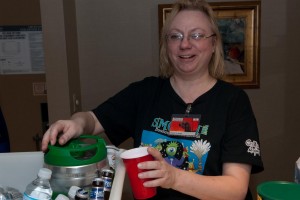
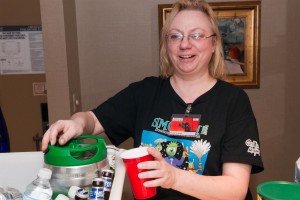
Often as simple as clicking a tool on something of a neutral color. Highlights on black clothing sometimes work. Gray hair sometimes works. (The worst cases get exceedingly nasty, but most are simple.)
This one came out of the camera fairly wonky, for no apparent reason (flash color is good, and this was bounced).
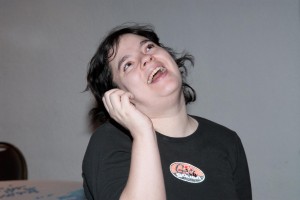

Picasa, Photoshop, Lightroom, Bibble, Aperture, Gimp, Elements, iPhoto. Can be very expensive. The absolutely free stuff has uglier workflows. The decent stuff has a learning curve.
Facebook, SmugMug, Picasa, Flickr, Zenfolio, many. Doesn’t impose on anybody. Can control levels of access if people are willing to help (get accounts).
Don’t let valuable data exist only there, though—annotations, especially basic identifications.
Privacy.
Phones, pads. Can control access, and easy to point out a photo. You get to watch.
Inkjet, photo paper, other. Album, postcard, framed on the wall, book. Target, Walgreens, Costco still do digital photos. Smugmug and Flickr and the online peopel will sell you prints mail-order. Inkjet printers are very good. They’re more expensive per print, but quick turnaround can let you get work done much faster.
You need to prepare your photos for the future.
Time. More and more, GPS coordinates too.
Writing on the back of a jpeg file. Do it in the master, so it shows up in all the derivative works.
People, places, events, dates.
No digital medium yet devised does very well on benign neglect; a digital archive needs to be actively managed.
Keep a set of backups away from where you keep your primary copies (if nothing else, sick ’em in a drawer at work). The big benefit of digital is that a copy is just like the original; exploit this!
Online backup may be workable for you. It’s automatic, and gets you an immediate off-site copy.
Copying to an external disk is probably the best overall choice right now. Have at least two, preferably three, backup disks; if lightning strikes while writing your new backup over your old backup, your can lose your original and all your backups at once. So overwrite your oldest backup while the newest is not connected.
Optical disks can be good, but they’re rather small, and the lifetime of media varies a lot. Use good media, ideally MAM gold archival or equivalent. They are a pain to make and to check, especially if you’re making multiple copies.